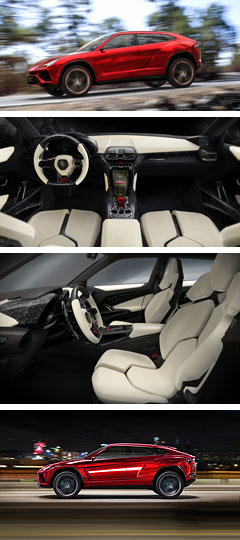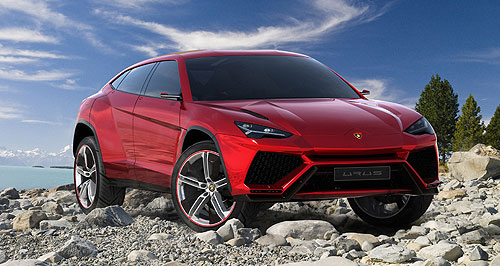Make / Model Search
Future models - Lamborghini - UrusBeijing show: Lambo unwraps Urus SUV conceptBig in the back: Lamborghini has sculpted some surprisingly rounded but still muscular-looking haunches for the rear of its Urus SUV concept. Lamborghini’s 440kW, low-CO2 SUV concept expected to help triple sales23 Apr 2012 LAMBORGHINI used this week’s Beijing motor show to unveil its Urus SUV concept, which is tipped to go into production by 2016 and serve as a competitor to the big BMW X6 M. The Italian supercar brand’s sales increased 23 per cent last year to 1602 units, and it says annual production of the Urus could be around 3000 units – signifying an almost tripling in volume. A long-rumoured project, Lamborghini’s SUV is unlikely to be powered by a V12 engine as speculated, given Lamborghini’s claims of best-in-class CO2 emissions and lightweight design. Overseas reports suggest an Audi-sourced twin-turbo V8 will form the basis of a 440kW plug-in hybrid drivetrain, signifying how much the world has moved on since the Urus’ spiritual predecessor, the tank-like, 336kW V12-powered LM002 off-roader launched in 1986. “One target is clearly defined,” said the press release announcing the vehicle. “The Lamborghini Urus will beat all comparable competitors when it comes to CO2 emissions.” In addition to lightweight body construction using Lamborghini’s ‘Forged Composite’ carbon-fibre technology, which it debuted on the Sesto Elemento concept, the Urus will feature a lightweight interior design. With permanent all-wheel drive and adjustable ride height, the Urus is lower than it is wide, measuring 1990mm in width, 1660mm in height and 4990mm in length – making it slightly longer, lower and wider than the X6 M. Helped by the low weight and a low centre of gravity, Lamborghini claims the Urus will set “new benchmarks” in terms of handling and will employ adaptive aerodynamics, such as an adjustable front spoiler that can also retract to provide a better approach angle and obstacle clearance.  In addition, a wind deflector above the rear windscreen directs airflow at the adjustable rear spoiler, which automatically adjusts the aerodynamic balance to suit the driving conditions. In addition, a wind deflector above the rear windscreen directs airflow at the adjustable rear spoiler, which automatically adjusts the aerodynamic balance to suit the driving conditions.Although driving fun will be the priority, Lamborghini says it will not forget traditional SUV drawcards like space for people and their luggage, or flexibility for use with family and leisure pursuits. How the concept’s huge 24-inch wheels and technology-laden supercar-like four-seat interior fit into that equation remains to be seen, but these are expected to be among the first things to be toned down for the production car. Exterior styling, reportedly close to the real thing, means the angular Urus is instantly recognisable as a Lamborghini from the front by its devilish headlights and supercar-like front bumper with gaping air intakes. From the side, it shares a coupe-like roofline and shallow windows with the Range Rover Evoque, but with large air vents behind the front wheels that flow into a sharply creased indent in the doors. Towards the rear, that indent is dramatically truncated by exaggerated and surprisingly rounded haunches that give the car a muscular, aggressive stance, finished off by a tiny window, four hexagonal exhaust tips and slim LED tail-light clusters. The dark-coloured lower cladding fitted to most SUVs as a styling and protective feature is present on the Urus, but, being a Lamborghini, it is all naked carbon-fibre weave, including the front spoiler, wheelarches, side-skirts and chunky rear diffuser. Carbon-fibre is also evident throughout the interior – symbolic of Lamborghini’s aim to save weight inside as well as out – with this idea most clearly expressed through the centre console, which runs the length of the cabin and is made from a lightweight lattice of Lamborghini’s Forged Composite material. Forged Composite is also visibly used for the seat frames, its unique production process creating a surface texture and colouring more like marble or granite than traditional carbon-fibre weave. Large race-style steering-column-mounted paddles operate a dual-clutch transmission and, like recent Ferraris, Lamborghini has ditched the traditional column stalks for indicators, light and wiper controls, moving the switchgear to the multi-function steering wheel or centre console. The instrument panel takes the form of a programmable colour screen, while infotainment and climate-control functions are managed through a central touchscreen that is replicated between the rear seats for use by passengers. As is traditional for Lamborghini, the SUV’s moniker is bull-related, with Urus – also known as Aurochs – being the large, wild ancestor of domestic cattle. Spanish fighting bulls, after which most Lamborghini models are named, remain close to the Urus in appearance. Described by Lamborghini president and CEO Stephan Winkelmann as “a very concrete idea for the future of Lamborghini”, an SUV is now the most likely choice the company will make for its third model. It has already explored a four-door luxury sedan with its 2008 Estoque concept and confirmed in May last year that it will produce a vehicle suitable for everyday use. Mr Winkelmann told British journal Autocar the Estoque was “placed on hold because of the lack of a suitable platform”, but said the company has not “given up on the idea entirely”. He said it is clear an SUV “offers the best opportunity for success” and that Lamborghini needs to broaden its customer base if it is to secure long-term profitability. “Our studies have shown that nearly all existing Lamborghini owners also have a sport utility vehicle in their garage, so in this respect we consider it the perfect extension to our existing supercar business.” Lamborghini says its primary target markets for the Urus are the US, the UK, Germany, Russia, the Middle East and China – and unveiling the car on Chinese soil again points to the importance luxury and sportscar-makers now place on that market. “SUVs stand for freedom and emotion,” said Mr Winkelmann. “SUVs make up one of the most successful market segments worldwide. The Urus is the most extreme interpretation of the SUV idea it is the Lamborghini of SUVs.” The Urus will likely share a platform with other Volkswagen Group SUVs including the Porsche Cayenne, Audi Q7 and VW Touareg. A production version of Bentley’s controversial EXP 9 F SUV concept, unveiled at the Geneva show last month, would also ride on the same underpinnings.  Read more15th of March 2012  Lambo Gallardo auto for freeSavings of up to $47,000 as Lamborghini repositions its entry-level Gallardo range6th of March 2012  Geneva show: Bentley builds an SUVShock and awe in Geneva as Bentley unveils production-oriented SUV concept6th of March 2012  Geneva show: Lambo’s one-off roofless AventadorLamborghini to sell one-of-a-kind Aventador J Roadster to member of the publicAll motor show Alfa Romeo Alfa Romeo Abarth Abarth Alpine Alpine Alpina Alpina Audi Audi Aston Martin Aston Martin BMW BMW Bentley Bentley Chery Chery Brabham Brabham Chrysler Chrysler Chevrolet Chevrolet Cupra Cupra Citroen Citroen DS DS Dodge Dodge Fiat Fiat Ferrari Ferrari Foton Foton Ford Ford Great Wall Great Wall FPV FPV Haval Haval GWM GWM Honda Honda Holden Holden Hummer Hummer HSV HSV Infiniti Infiniti Hyundai Hyundai Jaguar Jaguar Isuzu Isuzu Kia Kia Jeep Jeep Land Rover Land Rover Lamborghini Lamborghini Lexus Lexus LDV LDV Mahindra Mahindra Lotus Lotus Mazda Mazda Maserati Maserati Mercedes-AMG Mercedes-AMG McLaren McLaren MG MG Mercedes-Benz Mercedes-Benz Mitsubishi Mitsubishi Mini Mini Opel Opel Nissan Nissan Peugeot Peugeot Pagani Pagani Proton Proton Porsche Porsche Renault Renault Ram Ram Rover Rover Rolls-Royce Rolls-Royce Skoda Skoda Saab Saab SsangYong SsangYong Smart Smart Suzuki Suzuki Subaru Subaru Toyota Toyota Tesla Tesla Volvo VolvoMotor industry news |
Click to shareAll motor show Alfa Romeo Alfa Romeo Abarth Abarth Alpine Alpine Alpina Alpina Audi Audi Aston Martin Aston Martin BMW BMW Bentley Bentley Chery Chery Brabham Brabham Chrysler Chrysler Chevrolet Chevrolet Cupra Cupra Citroen Citroen DS DS Dodge Dodge Fiat Fiat Ferrari Ferrari Foton Foton Ford Ford Great Wall Great Wall FPV FPV Haval Haval GWM GWM Honda Honda Holden Holden Hummer Hummer HSV HSV Infiniti Infiniti Hyundai Hyundai Jaguar Jaguar Isuzu Isuzu Kia Kia Jeep Jeep Land Rover Land Rover Lamborghini Lamborghini Lexus Lexus LDV LDV Mahindra Mahindra Lotus Lotus Mazda Mazda Maserati Maserati Mercedes-AMG Mercedes-AMG McLaren McLaren MG MG Mercedes-Benz Mercedes-Benz Mitsubishi Mitsubishi Mini Mini Opel Opel Nissan Nissan Peugeot Peugeot Pagani Pagani Proton Proton Porsche Porsche Renault Renault Ram Ram Rover Rover Rolls-Royce Rolls-Royce Skoda Skoda Saab Saab SsangYong SsangYong Smart Smart Suzuki Suzuki Subaru Subaru Toyota Toyota Tesla Tesla Volvo VolvoMotor industry news |











Facebook Twitter Instagram